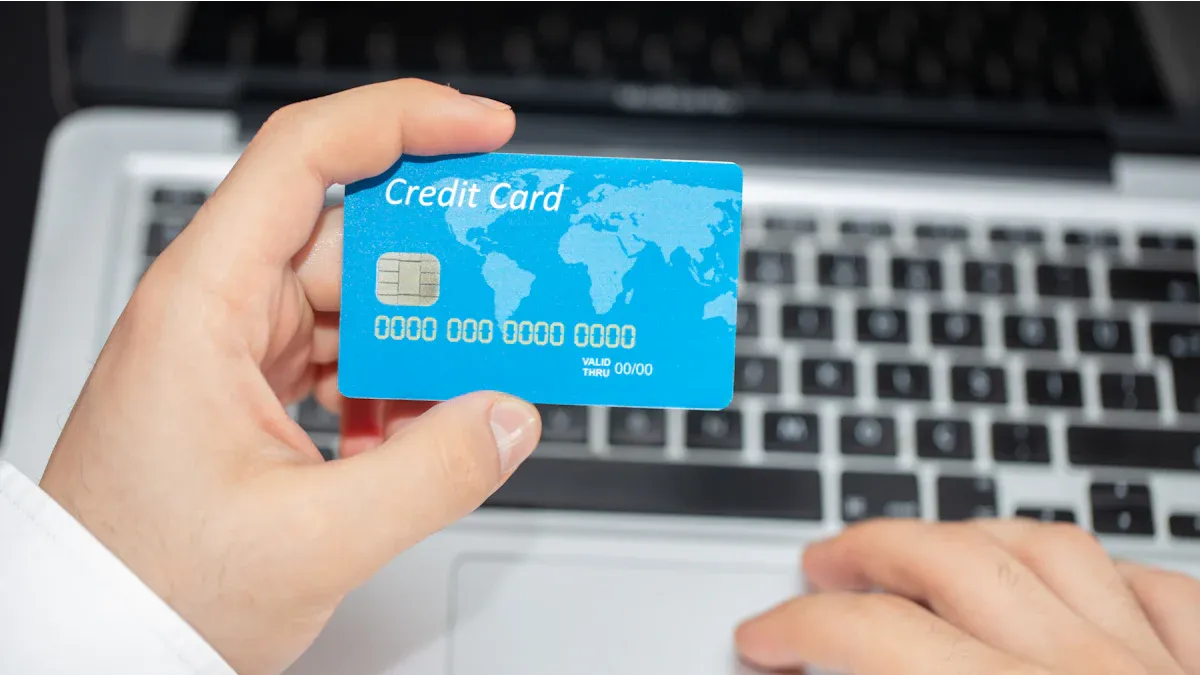- EasyCard
- Trade
- Help
- Announcement
- Academy
- SWIFT Code
- Iban Number
- Referral
- Customer Service
- Blog
- Creator
How Does the IBAN Remittance Method Bring Security, Convenience, and Efficiency to Global Transfers?

Image Source: unsplash
Have you ever worried about a transfer going wrong due to entering a long, complex bank account number incorrectly? A small mistake could lead to funds being sent to the wrong account, or even becoming unrecoverable.
The IBAN remittance method addresses this issue from the source through its unique design. Its standardized format and built-in validation function effectively reduce errors and delays caused by account information confusion, bringing unprecedented security, convenience, and efficiency to global fund transfers.
Key Points
- IBAN effectively reduces transfer errors and fraud through its built-in check digits and standardized format, ensuring fund security.
- IBAN simplifies the international transfer process, requiring only one number to complete the operation, making global payments more convenient.
- IBAN’s automated processing capabilities significantly reduce fund arrival times, improving transfer efficiency.
- Virtual IBAN (vIBAN) is an innovation of IBAN, helping businesses better manage and track multiple receipts.
- Using IBAN for transfers provides a safer and more efficient global payment experience, but recipient information still needs verification.
IBAN’s Security: How Does It Prevent Risks from the Outset?
When handling large or important international transfers, security is undoubtedly the top priority. The core of IBAN’s design is to minimize risks to the greatest extent. It establishes a robust defense line at the start of the transfer journey through a sophisticated mechanism, effectively preventing fund losses due to information errors and fraudulent activities.
Built-in Check Digits: Automatically Detecting Account Errors
Have you ever wondered how a banking system instantly knows whether an IBAN number’s format is correct when you enter it? The answer lies in IBAN’s “built-in check digits” (Check Digits).
It’s like a built-in “mathematical magic.” The third and fourth digits of an IBAN number are the check digits, calculated based on the rest of the account number using an international standard algorithm called MOD-97. When you enter an IBAN in online banking or a transfer app, the system immediately performs this algorithm:
- The system recalculates the check digits using the account information you entered.
- It compares the calculated result with the original check digits you provided.
- If they don’t match, the system instantly displays an error message, preventing you from proceeding further.
This simple automated validation step effectively intercepts the vast majority of manual input errors, such as entering incorrect digits or reversing their order, before the transfer is initiated. It ensures your funds won’t be sent to a non-existent account due to an innocent mistake, avoiding unnecessary trouble and losses from the outset.
Standardized Format: Effectively Reducing Fraud Possibilities
One major risk of traditional transfers is the vast variety of account formats across countries, which creates opportunities for fraudsters. They can forge seemingly legitimate account information to trick you into sending funds to the wrong account.
IBAN’s globally standardized format greatly enhances transparency, making fraudulent activities harder to succeed. Since each country’s IBAN has a fixed length and structure (e.g., DE for Germany, GB for the UK), you and the bank can more easily identify whether the account’s origin and basic format are correct.
This clear structure helps prevent some common international transfer scams, such as:
- Business Email Compromise: Fraudsters impersonate your supplier and provide a fake receiving account. If the provided IBAN is incorrectly formatted, you or the banking system can easily detect it.
- Invoice Fraud: Criminals tamper with payment details on legitimate invoices. The standardized IBAN makes verification much simpler and more straightforward.
- Account Hijacking: After gaining access to your account, hackers may attempt to transfer funds to illegal accounts. IBAN’s validation mechanism adds an extra layer of verification for the bank’s risk control system.
While IBAN cannot completely eliminate all fraud, such as phishing, its uniform and verifiable format significantly reduces fraud risks related to the account information itself.
Pre-Transfer Verification: Ensuring Funds Reach Their Destination Accurately
Even though the IBAN system is highly secure, you still need to stay vigilant. IBAN’s check digits can confirm the account format’s validity but cannot verify whether the account truly belongs to your intended recipient.
Important Reminder: Before initiating any international transfer, always double-check the IBAN number and recipient’s name through reliable channels (e.g., direct phone communication with the recipient or verified official emails). This is the simplest and most effective way to prevent fund losses.
For businesses handling large transaction volumes, professional pre-transfer verification services are also available. Institutions like IBAN.com, Greip, and ClearDil provide API tools that can validate IBANs in real-time before transfers and, in some cases, even check if the recipient’s name matches, adding an extra layer of security to your funds.
IBAN Remittance’s Convenience: Simplifying Global Payments

Image Source: pexels
Beyond security, one of the biggest headaches in international transfers is filling out tedious recipient information. You need to repeatedly verify bank names, branch addresses, account numbers, and various codes, where a single mistake could lead to transfer failure. One of the core advantages of the IBAN remittance method is that it makes this complex process extremely simple.
Simplified Information Entry: Just One IBAN Number
Imagine no longer having to face a long list of fields to fill out. With IBAN, you only need one standardized number to complete the entire operation.
Traditional international transfers typically require multiple pieces of information, but the IBAN remittance method consolidates them into one. This brings obvious convenience:
- Eliminating Format Confusion: You no longer need to study the unique account formats of different countries. As a universal identifier, IBAN allows you to use a consistent format for transfers to any IBAN-supporting country.
- Simplifying Payment Operations: On the bank’s transfer page, you only need to accurately enter the recipient’s IBAN. The system automatically identifies the country, bank, and account, sparing you the hassle of manually filling out and verifying multiple fields.
- Reducing Common Errors: The standardized format and built-in validation function effectively prevent payment delays or failures due to manual input errors, avoiding additional rejection fees.
Let’s look at a simple comparison to see how much IBAN changes things:
Information Required for Transfer Traditional Method (Example) IBAN Method Core Information Bank name, branch code, account number, recipient address Just one IBAN number Supporting Code SWIFT/BIC code SWIFT/BIC code You’ll find that when IBAN is used in combination with the SWIFT/BIC code, the payment process is greatly simplified. IBAN serves as the primary account identifier, while the SWIFT/BIC code specifies the bank, together facilitating automated processing of cross-border payments. This contrasts sharply with codes like sort codes used mainly for domestic transfers in specific regions (e.g., the UK and Ireland), which are more prone to errors in international transactions.
Globally Recognized: Supporting Multiple Major Currencies
IBAN’s convenience is not only reflected in its simplified format but also in its widespread global acceptance.
The IBAN standard was initially introduced in Europe, and now, over 80 countries and regions have adopted it. This means that whether your business partners or family are in Germany, France, the UAE, or Brazil, you can use the unified IBAN remittance method to handle fund transactions. You don’t need to learn a new set of bank account rules for each country, significantly reducing the complexity of cross-border payments.
This widespread acceptance makes IBAN a true global payment tool. It supports settlements in multiple major currencies, such as the euro (EUR), pound sterling (GBP), and US dollar (USD). When you need to pay a European supplier in euros or a UK school in pounds, a single IBAN number clearly points to the recipient’s account, making your global payment experience as smooth as a local transfer.
IBAN’s Efficiency: Why Does It Make Transfers Faster?

Image Source: unsplash
In today’s fast-paced world, nobody wants to wait. Traditional international transfers often take 3-5 business days, and such long waits can cause anxiety. IBAN was introduced to address this efficiency challenge. Through highly automated processing, it allows your funds to reach their destination faster and more accurately.
Automated Processing: Significantly Reducing Arrival Times
Have you ever wondered why some international transfers can arrive almost instantly? The answer lies in “Straight-Through Processing” (STP).
IBAN’s standardized format is key to enabling STP. When you initiate a transfer, the bank’s system can automatically read and verify the IBAN information without human intervention. This process is like an automated assembly line: funds leave your account, pass through system processing, and are delivered directly to the recipient, significantly reducing time wasted on manual reviews, data entry, and error troubleshooting.
In regions widely adopting IBAN, such as the Single Euro Payments Area (SEPA), this efficiency is fully realized. Through mechanisms like SEPA Instant Credit Transfer (SCT Inst), funds can reach the recipient’s account in as little as 10 seconds, available 24/7 year-round. This is driven by the automation advantages brought by IBAN standardization.
Reducing Bank Costs: Indirectly Saving User Fees
Efficiency improvements don’t just save time—they also directly impact your wallet. The less manual intervention a bank requires to process your transfer, the lower its operational costs.
IBAN’s automated processing helps banks save costs in several ways:
- Reducing Manual Intervention: Automated systems reduce the need for manual reviews and data entry.
- Lowering Error Handling Costs: IBAN’s built-in validation function significantly reduces transfer failures and returns, sparing banks the resources needed to investigate and resolve issues.
- Improving Operational Efficiency: Faster processing speeds allow banks to handle more transactions in the same amount of time.
These cost savings ultimately benefit you through lower service fees or fewer penalties. When you use IBAN, you’re not only choosing a faster method but also a more cost-effective global payment solution.
The Future of IBAN: Virtualization and More Possibilities
The IBAN system is not standing still. With the rapid development of financial technology, it is evolving into a more powerful and flexible tool, paving the way for the future of global payments. Among these, virtual IBAN (vIBAN) is one of the most exciting innovations.
Understanding vIBAN: Bridging Traditional and Modern Finance
If you manage multiple receipts, such as funds from different clients or projects, you might find accounting overwhelming. Virtual IBAN (vIBAN) was created to address this issue.
You can think of a vIBAN as a virtual sub-account. It has the same standard format as a regular IBAN but is not directly tied to an independent physical bank account. Instead, you can generate multiple vIBANs, all linked to a single main account.
This design makes fund management exceptionally clear. For example, you can assign a unique vIBAN to each client. When a client makes a payment, the funds are automatically deposited into your main account, with the system recording which vIBAN the payment came from. You don’t need to review complex payment references to instantly know who the payer is, greatly simplifying the reconciliation process.
The following table clearly illustrates the core differences between traditional IBAN and vIBAN:
| Feature | Traditional IBAN | Virtual IBAN (vIBAN) |
|---|---|---|
| Associated Account | Linked to a single physical bank account | Multiple can be generated, all linked to one main account |
| Main Purpose | Simple fund transfers | Transaction tracking, simplified reconciliation, multi-currency processing |
| Fund Management | Basic fund transfers | Efficient fund separation and automated reconciliation |
| Privacy | Sharing an IBAN shares the account identifier | Only the virtual number is shared, protecting underlying main account information |
Future Trends: The Digital Evolution of Transactions
The emergence of vIBAN signals that global payments are moving toward deeper digitization. It is not just a management tool but a cornerstone of financial innovation.
- Empowering Fintech: Fintech companies are leveraging vIBAN to offer more innovative services. Through API interfaces, they can embed vIBAN functionality into their applications, helping businesses easily handle global payments, establish localized collection capabilities, and reduce operational costs by up to 30%.
- Bridging Traditional and Crypto Worlds: IBAN’s evolution even extends to the digital currency space. Some cutting-edge companies have introduced “crypto IBANs,” allowing you to manage fiat currencies like the euro and digital assets like Bitcoin within the same account system. This provides a unified channel for receiving and converting different types of funds, significantly lowering the barrier to entering the crypto market.
vIBAN is becoming a key component of embedded finance. In the future, payment functions will seamlessly integrate into various business software and platforms. When you use IBAN or vIBAN, you’re not just completing a transfer—you’re experiencing a modern, globally connected, efficient, and ever-evolving financial network.
From built-in check digits to automated processing, the IBAN remittance method has brought revolutionary improvements in security, convenience, and efficiency. Innovations like vIBAN further highlight its immense potential. For example, financial services company BCB Group, by adopting a vIBAN solution, achieved a transaction volume growth of over 400%, greatly simplifying the reconciliation process.
The next time you handle an international transfer, make sure to prioritize requesting and using an IBAN. This will allow you to enjoy a safer and more efficient global payment experience.
FAQ
What’s the Difference Between IBAN and SWIFT/BIC Codes?
You can think of IBAN as your home’s detailed doorplate number, precisely locating your account. The SWIFT/BIC code is like the post office your home is served by, guiding funds to the correct bank. Together, they ensure the transfer reaches its destination accurately.
Does Mainland China Support IBAN Transfers?
Currently, mainland China’s banking system does not use the IBAN standard. When transferring to mainland China, you still need to provide the receiving bank’s SWIFT/BIC code, account number, and other traditional information. IBAN is mainly used in Europe and over 80 other countries and regions.
What Happens If I Accidentally Enter the Wrong IBAN?
IBAN’s built-in validation function takes effect immediately. If the format you enter is incorrect, the banking system typically displays an error message right away, preventing you from proceeding with the transfer. This effectively prevents funds from being sent to a non-existent account.
Do I Still Need a SWIFT/BIC Code If I Have an IBAN?
Yes, in most international transfers, both are required. IBAN identifies your personal account, while the SWIFT/BIC code identifies the receiving bank. You can think of them as an efficient duo, working together to ensure your transfer is completed quickly and accurately.
*This article is provided for general information purposes and does not constitute legal, tax or other professional advice from BiyaPay or its subsidiaries and its affiliates, and it is not intended as a substitute for obtaining advice from a financial advisor or any other professional.
We make no representations, warranties or warranties, express or implied, as to the accuracy, completeness or timeliness of the contents of this publication.




Contact Us
Company and Team
BiyaPay Products
Customer Services
is a broker-dealer registered with the U.S. Securities and Exchange Commission (SEC) (No.: 802-127417), member of the Financial Industry Regulatory Authority (FINRA) (CRD: 325027), member of the Securities Investor Protection Corporation (SIPC), and regulated by FINRA and SEC.
registered with the US Financial Crimes Enforcement Network (FinCEN), as a Money Services Business (MSB), registration number: 31000218637349, and regulated by FinCEN.
registered as Financial Service Provider (FSP number: FSP1007221) in New Zealand, and is a member of the Financial Dispute Resolution Scheme, a New Zealand independent dispute resolution service provider.




















